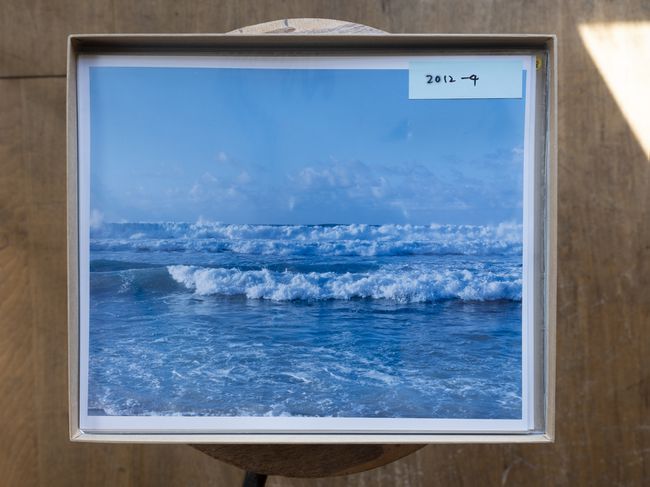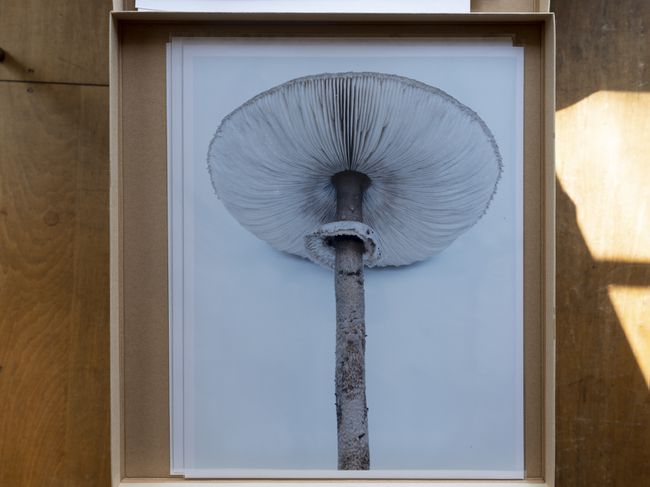New Documentary
Takashi Homma in conversation with Stefano Graziani and Bas Princen
This oral history was filmed by Jonas Spriestersbach in December 2022 at Takashi Homma’s studio in Tokyo. It is part of the CCA project The Lives of Documents—Photography as Project, an open reflection on how past and contemporary image-making practices serve as critical tools to read our built environment and design today’s world.





- BP
- When did you start thinking about waves, and why did you want to photograph them?
- TH
- New Waves began in 2000 when I went to Hawaii to photograph waves for a magazine commission. I photographed several waves, at first only for the magazine. But after that first visit, I realized that the project related to the photographic problem of the decisive moment without capturing any particularly decisive moments, so I continued to photograph waves. After five or six years, I began to compare my photographs of waves to wine—people can collect Takashi’s 2011 vintage photo of waves as though it was a vintage wine. That’s why I continue to photograph new waves.
- BP
- Was it Alfred Stieglitz who photographed clouds in the last part of his life? A beautiful catalog raisonné assembles every photograph he took, and clouds take up two-thirds of the two big volumes. Every print is reproduced in its original size, so sometimes several prints look the same. They emphasize the act of taking time in viewing and the fact that the same object can be beautiful in different formats. Every issue of New Waves features similar photographs, but they’re not the same. Is this intentional?
- TH
- Some photographers walk and shoot like hunters. But for my photography of waves, I fix the camera on the water; I wait, I don’t move, I wait for them to come to me. I take all my wave photos at the same beach on the North Shore of Hawaii, in the morning after sunrise, in good, natural light, using ten or twenty sheets. I’m interested in working according to a more fundamental approach to photography.
- BP
- How long will you continue photographing waves?
- TH
- I don’t know—until I pass away. I think lifetime projects are important. I have three or four ongoing projects.
- SG
- What do you consider your lifetime projects?
- TH
- Mushroom, Tokyo, architecture, and portraiture.
New Waves (2000 – )
Life of the Project
2000
Homma shoots the beach on the southern shore
of Oahu, Hawaii, USA for the first time
2003
Magazine: “New Waves by Takashi Homma,” in Relax, no. 75.5
Published by Magazine House Mook, Tokyo, Japan as special issue
2003
Exhibition: Waves
Organized at Gallery 360, Tokyo, Japan
28 January – 16 February 2003
2003
Publication: New Waves
Published by A.P.C., Tokyo, Japan with an essay by Jean Touitou
2005
Exhibition: New Waves
Organized at Gallery 360, Tokyo, Japan
1 April – 23 April 2005
2007
Exhibition: New Waves
Organized at Gallery 360, Tokyo, Japan
8 April – 26 April 2007
2007
Exhibition: New Waves
Organized at Logos Gallery, Tokyo, Japan
8 June – 26 June 2007
2007
Publication: New Waves
Published by Parco Publishing, Tokyo, Japan
2010
Exhibition: New Waves
1223 Gendaikaiga—Contemporary Painting Museum, Tokyo, Japan
3 June – 1 August 2010
2010
Publication: New Waves
Published by Parco Publishing, Tokyo, Japan
2012
Exhibition: New Waves
Organized at Gallery 360, Tokyo, Japan
25 July – 25 August 2012
2013
Exhibition: New Waves 2000–2013
Organized at Longhouse Projects, New York, USA
12 September 2012 – 31 October, 2013
2013
Publication: New Waves 2000–2013
Published by 1223 Gendaikaiga, Tokyo, in connection with the exhibition at Longhouse Projects, with an essay by philosopher and art critic David LaRocca
2017
Exhibition: New Waves
Organized at Post, Tokyo, Japan
2017
Publication: New Waves
Published by Post, Tokyo, Japan, it includes an essay by Selva Barni
- SG
- You’ve explored the issue of the documentary in your work, especially in your photographs of mushrooms. How do you relate to the documentary?
- TH
- I call this type of project “new documentary.” Photojournalism is a mode of documentary photography, but my way approaches the documentary slightly differently. Somebody once referred to my approach as a private or intimate documentary, but the phrase new documentary suits me well.
- SG
- Did you start the mushroom project while photographing waves, or did it begin afterwards?
- TH
- I published Mushrooms from the forest in 2011, just after the big Tōhoku earthquake. Before that event, I was interested in mushroom photography, but I didn’t know how to make my interest into a project. After the disasters, I realized I should photograph mushrooms at Fukushima Mountain.
- SG
- What is the relationship between the mushrooms and the Fukushima disaster, if there is one?
- TH
- After the Fukushima nuclear disaster in 2011, radioactive mushrooms grew on the mountain. The government prohibited anyone from taking wild mushrooms from the site. On the contrary, I thought I should go to the mountain and shoot mushrooms.
I also compare finding mushrooms to taking photographs. A mushroom might disappear from one day to the next. - SG
- So, in a way, this project, like the waves, is a self-reflexive one.
- TH
- I would say that the project is a bit more ambiguous because collecting mushrooms is like taking a snapshot of a moment—neither act offers a second chance.
- SG
- It’s documentary
- TH
- Yes, new documentary.
Mushrooms (2011 – )
Life of the Project
2011
The author visits the Fukushima Prefecture to document mushrooms
in the forests surrounding the nuclear power plant site of the March 2011 fallout
2011
Exhibition: その森の子供 mushrooms from the forest 2011
Organized by Blind Gallery, Tokyo, Japan
17 December 2011 – 29 January 2012
2011–2015
The author travels to Sweden and Finland, countries where wild mushroom consumption
was prohibited in the immediate aftermath of the 1986 Chernobyl nuclear accident
2012
Exhibition: 外国のキノコ MORE Mushroom
Organized by The Cave, Tokyo, Japan
1 January – 14 February 2012
2012
Publication: その森の子供 mushrooms from the forest 2011
Published by Blind Gallery, Tokyo, Japan
2015
Publication: Scandinavian Mushroom
Produced by Yusuke Nakajima and Yoshihisa Tanaka, Tokyo, Japan
2017
The author travels to Chernobyl, Ukraine to document mushrooms
thriving in the human-free exclusion zone surrounding the nuclear power plant site of the 1986 fallout
2018
The author travels to Stony Point, NY to document mushrooms surrounding
the artist commune where experimental composer and mycologist John Cage lived
2019
Publication: Symphony その森の子供: mushrooms from the forest
Published by Case Publishing, Tokyo, Japan
2020
Exhibition: Symphony その森の子供: mushrooms from the forest
Organized at Post, Tokyo, Japan
1 January – 23 February 2020
2021
Exhibition: ホンマタカシ New Mushrooms From the Forest
Organized at Taro Nasu Gallery, Tokyo, Japan
10 July – 7 August 2021
2022
Exhibition: The Art of Mushrooms
Group exhibition at the Serralves Foundation, Porto, Portugal
28 June 2022 – 30 June 2023
- BP
- In an earlier conversation, you discussed the mushroom project in connection to literature. You told us that the mushroom is more like a poem, while nature is like a book.
- TH
- Russian novelists like Tolstoy or Dostoevsky are authoritative figures, but I prefer Chekhov. Chekhov only wrote short stories and screenplays. A literary critic once wrote about their work by comparing Tolstoy and Dostoevsky to big trees and Chekhov to tiny mushrooms. I like that expression because I prefer counterculture to monumental architecture.
- BP
- Both the waves and the mushrooms are about nature. Was this a conscious choice?
- TH
- No, this wasn’t conscious. But since waves can refer to sound waves or wavelengths and not only water, I’m always aware of the subtle waves emitted by mushrooms in the mountain.
- BP
- Is composition important to you?
- TH
- I don’t take composition so seriously, even when using a 4 × 5 camera. I mostly care about focus. Also, I’m a very quick photographer. People who work with me are often surprised by how quickly I work.
I lived in London for two years in 1999 and worked for i-D Magazine. Terry Jones, the editor-in-chief at the time, told me to focus on straight-up photography, an approach I like very much. You photograph what you see. - BP
- How do you stay free and avoid overthinking technique?
- TH
- It’s important to be free, which comes with pursuing ongoing projects. I think proper photographers think too much about technique. It’s necessary to do lifetime projects to avoid focusing too strongly on technique. If I use a specific technique, it’s for a single and finished project.
- BP
- Yes, because if a photograph is about a technique, you mostly see its technicality. Technique becomes the feature that defines the project. Do you look through the camera or not?
- TH
- It depends. I used a 4 × 5 camera to photograph waves, so I couldn’t see through the viewfinder. I didn’t even look at the waves; I only changed the film. Like with actors, the happy moment for me as a photographer happens when I see the image.
- BP
- Your prints are beautiful but very different from the books. They have both more and less colour, cold but still warm. How do you do this?
- TH
- I follow normal procedures—I use a normal printer and normal ink. People often ask about my printing technique, as if there is some secret. I don’t care so much about how the quality of printing or how they’re exhibited. Last year, I did an exhibition on the mushrooms in Los Angeles and sent them the data, and they printed and displayed the images in large and small formats. I think sending the data of a project is a type of conceptual art.
My books can be hardcover, but it’s not necessary. I prefer printing them as zines or brochures. If my photography is good, I don’t care about the size of my pictures, their format, or the printing method. Live music is fantastic, but the music I hear on the radio or in a car is good, too. That’s why I’m not particular about how my work is presented—I care that my photos are seen.

